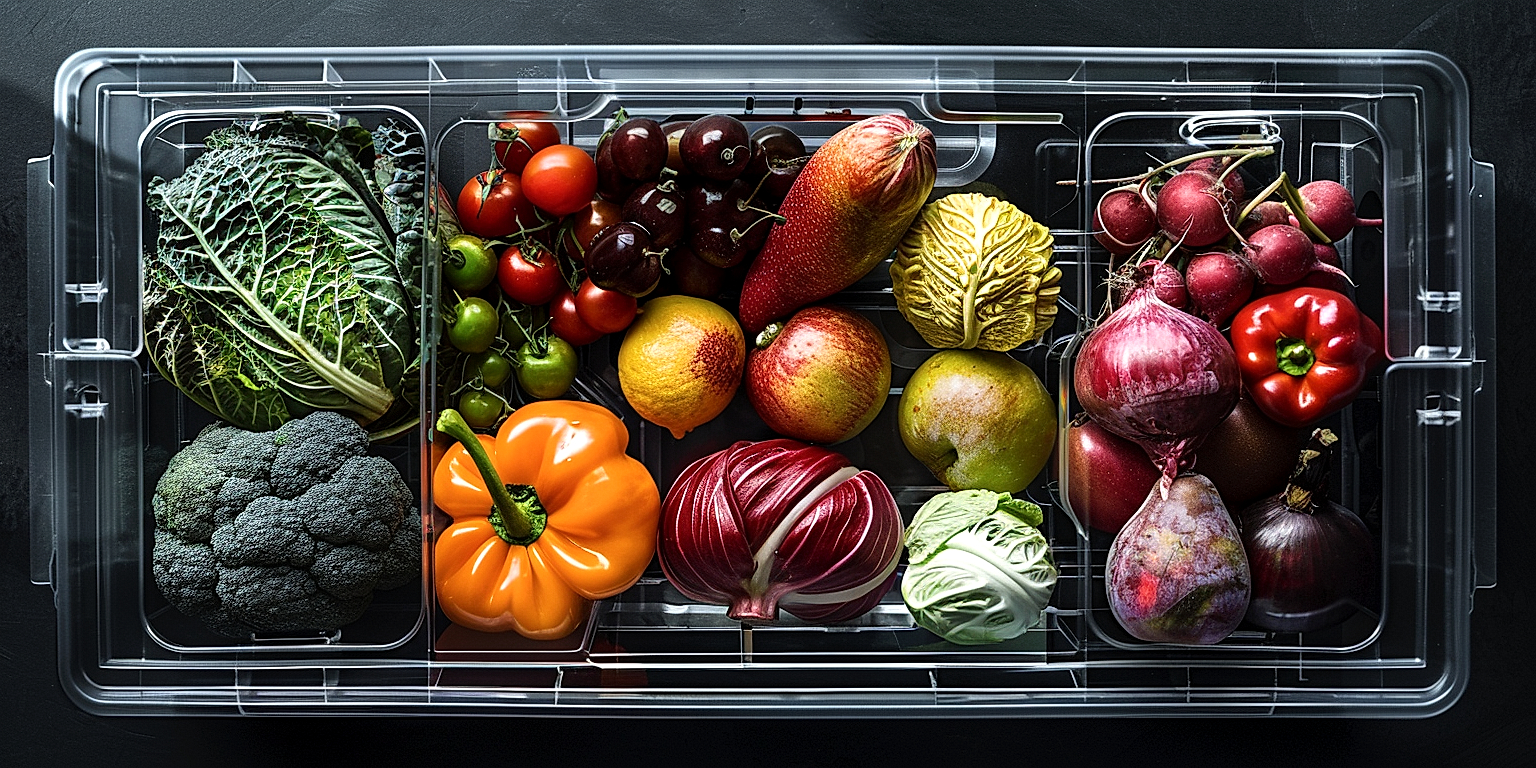In the ever-expanding world of online retail, few sectors have seen as much growth as the fresh produce industry.
The shift towards digital platforms has opened up a new set of challenges, notably, the effective packaging of these perishable goods for home delivery.
With the fragile nature of fruits and vegetables, packaging plays a critical role in maintaining the quality and freshness of the produce.
However, it’s not as easy as it may seem.
There are several factors to consider, from the choice of packaging materials to the assembly process.
In this blog, we delve into some practical strategies to help optimize your e-commerce packaging for fresh produce.
Contents
E-commerce Packaging Tips For Fresh Produce
1. Use sturdy, eco-friendly packaging materials.
In the world of e-commerce, packaging plays a crucial role in preserving the freshness and integrity of fresh produce during transport.
Opting for sturdy, eco-friendly packaging materials not only ensures the safety of the items but also aligns with the increasing consumer demand for sustainable practices.
The first step in achieving this is understanding the different types of materials available in the market.
Amongst all, materials like recycled cardboard, biodegradable plastics, and compostable mailers have proven to be both sturdy and eco-friendly.
Recycled cardboard is particularly popular due to its remarkable strength and biodegradability.
Moreover, these packaging materials are capable of withstanding the demands of the delivery process, such as changes in temperature and handling shocks.
Companies, therefore, need to consider the physical characteristics of the fresh produce they are packaging when choosing materials.
For example, a company selling organic fruits might opt for sturdy, corrugated cardboard boxes with segmented compartments to prevent bruising.
Produces like leafy greens, on the other hand, might require eco-friendly plastic containers that allow for a certain level of breathability.
Opting for eco-friendly packaging materials is not just environmentally beneficial, but can also be a strategic decision for the brand’s image.
Studies have found that consumers are more likely to support businesses that incorporate sustainable practices into their operations, including the use of eco-friendly packaging materials.
Businesses should be transparent about their use of such materials, leveraging it as part of their branding and marketing strategy.
For instance, they can clearly state on their shipping boxes, product labels, and marketing materials that they use 100% recycled or eco-friendly packaging.
Moreover, having a package return and recycle program would encourage consumers to participate in waste reduction and create a positive impact on the environment.
Lastly, aside from environmental benefits and enhanced brand image, switching to eco-friendly packaging materials could yield cost savings in the long run.
As the demand for sustainable materials increases, the cost continues to decrease, making it a viable option for many e-commerce businesses.
2. Incorporate Proper Cooling Elements
Incorporating proper cooling elements is an essential step in packaging fresh produce for e-commerce.
When it comes to e-commerce, maintaining the freshness and quality of the produce is crucial.
Using appropriate cooling methods preserves the quality of the produce during the shipping process, preventing it from spoilage and damage due to heat and sunlight.
The type of cooling method used often depends on the specific type of produce being shipped. Some fruits and vegetables require lower temperatures than others to stay fresh.
For instance, ice packs and gel coolants are commonly used for cooling. These maintain a low temperature inside the package, preserving the freshness of the produce.
Insulated foam containers are also a good option. Providing both insulation and cushioning, they are perfect for protecting delicate fruits and veggies.
Another effective cooling method is refrigerated shipping. However, it can be costly and not all delivery services offer this option. But for highly perishable goods, this investment is worthwhile.
It’s important to experiment with different cooling methods and figure out what works best for the specific kind of produce that you are shipping.
This ensures that the freshness of the produce is preserved from the time of packaging to the time it reaches customers.
Additionally, providing instructions for proper storage of the produce upon receiving can help maintain its freshness, even after delivery.
However, it’s not enough just to incorporate the right cooling elements into your packaging.
You also need to consider the overall package design to ensure that the cooling elements are effective.
For instance, the placement of cooling elements within the package can greatly affect how effectively they can maintain controlled temperatures inside.
On top of this, the packaging materials used should also help in maintaining the cool temperature within the package.
For instance, using an insulated box can help keep the cool air in and the warm air out. This way, the cooling elements won’t have to work as hard and can last longer.
Moreover, regular quality checks and reviews can also help in improving your packaging process and keeping your produce fresh.
3. Ensure airtight sealing for freshness.
One of the most critical factors in maintaining the freshness of produce in e-commerce packaging is the airtight sealing.
The oxygen in the air can accelerate the degradation of fresh produce, which leads to browning, and may also encourage the growth of microorganisms.
A properly sealed package prevents air from entering and interacting with the produce, thereby preserving freshness and extending shelf life.
The key to preserving freshness in e-commerce packaging for fresh produce is undoubtedly ensuring the seal is airtight. In every step of the packaging and shipping process, this seal must remain uncompromised to ensure the produce arrives at its destination in optimal condition.
There are various methods available for achieving an airtight seal, including heat sealing, induction sealing, and vacuum sealing.
Heat sealing provides an efficient and cost-effective method which involves the use of heat to melt a thermoplastic material, creating a seal once cooled.
On the other hand, induction sealing uses an electromagnetic field to heat a foil liner, which then adheres to the container’s rim, providing an airtight seal.
Vacuum sealing involves removing air from the package before sealing, which is ideal for preserving freshness as it effectively eliminates oxygen.
Whichever method is utilized, it’s crucial to ensure a secure and consistent seal to prevent air leakage, and subsequently, fresh produce spoilage.
This necessitates high-quality sealing equipment and materials, and perhaps even professional assistance to design and achieve an optimal packaging system.
While investing in a robust airtight sealing process might incur additional costs, it’s a worthy expenditure considering the potential financial losses associated with spoiled produce sparked by inadequate packaging.
Besides, customers always appreciate receiving high-quality, fresh produce, and a reliable airtight sealing process contributes significantly to ensuring this.
Preserving freshness is of utmost importance in the e-commerce packaging for fresh produce.
It balances the need to deliver high-quality products to customers and minimize the distributor’s costs associated with spoilage.
4. Use shock-absorbent packaging
As part of providing excellent e-commerce services, businesses dealing in fresh produce need to consider using shock-absorbent packaging.
This is because the transportation process can sometimes be rough and unfriendly, with produce subjected to various levels of shocks, vibrations, and impacts.
Shock-absorbent packaging is designed to minimize damage by spreading and reducing the force of impacts.
For example, if a box of fresh fruits drops during transportation, the shock-absorbent material would absorb the shock and protect the fruits from being squashed or damaged.
Using shock-absorbent packaging is a key strategy in ensuring the fresh produce reaches the customers in the premium condition.
In fact, some businesses underestimate the importance of this, and they end up dealing with unsatisfied customers returning damaged products or posting negative reviews about the received products.
Moreover, shock-absorbent packaging contributes to enhancing the consumers’ unboxing experience.
The unwrapping process is part of the customer experience, and finding damaged or spoiled fruits or vegetables can create a significantly negative impression.
Customers often perceive the quality of packaging as the reflection of the product’s quality itself, and poor packaging may turn potential customers away.
High-quality, shock-absorbent packaging not only safeguards the product, it also enhances the reputation of the seller.
Apart from using packaging materials like foam and bubble wrap, many e-commerce businesses now are starting to use eco-friendly shock-absorbent packaging materials, such as cornstarch-based packing peanuts and mushroom-based packaging.
These options are not only shock-absorbent, but they also minimize the environmental impact of packaging.
Investing in shock-absorbent packaging thus not only safeguards the product but also contributes to building a sustainable, environmentally friendly business.
Remember, packaging is not just for protecting the product; it is also an opportunity to communicate your brand value and standard to your customers.
Therefore, don’t skimp on packaging. Instead, invest in quality shock-absorbent packaging for your fresh produce shipments to maximise customer satisfaction.
5. Label packages with handling instructions
Packaging labeling plays a vital role when it comes to the delivery of fresh produce in e-commerce.
Specific handling instructions not only help delivery personnel handle the packages properly but also provide vital information to the consumers.
Labeling becomes more important when shipping fresh produce, as these items are prone to getting damaged easily if not handled properly.
Proper labels can communicate to all handlers the need for special care, minimizing the chances of mishandling, spoilage or damage during transit.
The most noticeable information on the packaging should be the “handle with care” label.
This instruction warns the handlers about the fragile content inside and alerts them to handle it gently.
Temperature control labels are also crucial, especially for fresh produce that needs to be kept in a certain temperature range during transport.
Moreover, the labels should also indicate which side is up to avoid placing the package upside down and causing potential damage to the produce.
There are even labels available that can actively show if a package has been tipped or dropped during the transportation process.
It is also recommended to include delivery speed labels to ensure that the courier knows to expedite the shipping process to maintain the freshness of the produce.
Instructions on what to do in case of package damage or spoilage are also beneficial and can help handle customer complaints.
Therefore, labeling is not an area that can be ignored or taken lightly while packaging fresh produce for e-commerce.
Through proper labeling, you can ensure that delivery personnel handle the packages properly and that customers know how to store and handle the produce upon receiving it.
Lastly, ensure to comply with regulations concerning labeling and packaging as it differs from place to place.
Labeling should be comprehensive but clear, for easy understanding and quick reference.
The Bottom Line
Adopting sustainable packaging practices is not only beneficial to the environment but can also enhance product quality.
Through integrating robust, eco-friendly packaging, incorporating adequate cooling elements, ensuring an airtight seal for freshness, utilizing shock-resistant packaging and providing clear handling instructions, we can significantly improve the shelf life and condition of a product.
Hence, these strategies represent a comprehensive approach to smart and sustainable product packaging that yields dividends in terms of environmental impact, product quality, and consumer experience.
It is a win-win situation for every stakeholder involved.




